|
|
|

|
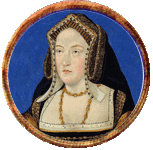
1. Catherine
of Aragon
Divorced |

2. Anne
Boleyn
Beheaded |
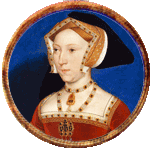
3. Jane
Seymour
Died |
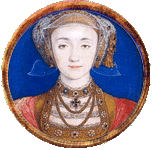
4. Anne
of Cleves
Divorced |
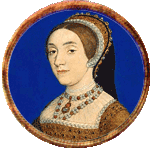
5. Catherine
Howard
Beheaded |
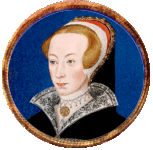
6. Katherine
Parr
Survived |
|
|
Six Wives of Henry VIII. An Overview of the Tudor Queens:
King Henry VIII, Tudor monarch, ruler of England in sixteenth-century Renaissance England, had six wives. The fates of the wives can be remembered as "Divorced, beheaded, died; divorced, beheaded, survived."
King Henry the Eighth in his youth was much like William Shakespeare's description of King Henry V — he was much more interested in arms and armor, swordplay, jousting, hunting, and women than in kingship. He wrote love poems and composed songs such as "Pastime with Good Company." Throughout his life, he also loved regal fashion — after all, what was royalty if one could not dress like a royal. There still remains an elaborate suit of armor worn by King Henry VIII at the Tower of London Museum. However, the British Isles had to have a ruler serious about the business of the commonwealth, and one of those concerns was taking a wife and begetting an heir to the throne of England. It was not long since the Wars of the Roses, and succession had to be secured.
Henry VIII's first wife, Queen Catharine of Aragon, who had been contracted to Henry's brother Arthur before his death, gave him a daughter, who was to become Queen Mary I, also known as Bloody Mary, for the number of Protestant executions in her reign. While married to Catharine, the King fell in love with Anne Boleyn to the point of obsession, which resulted in his desire to obtain a divorce. The Pope and the Catholic Church would not grant it, which resulted in King Henry VIII breaking from the church of Rome — in one swoop England became a protestant country; it is due to this one factor that the Anglican church, or Church of England, exists.
Henry VIII's second wife, Queen Anne Boleyn, gave birth to a daughter, who would later become Queen Elizabeth I, arguably the strongest and most successful monarch, King or Queen, in the history of Britain. The King still desired a male heir, a crown prince, and Anne Boleyn's contrary nature was wearing on the King. Anne Boleyn also had enemies at court, who helped bring about her downfall; accused of adultery and plotting to kill the king, and thus treason, there was no way for Anne to go, but to the headsman's block. The King had already begun to court one of the ladies of the court, Jane Seymour, whom he married shortly after.
Henry VIII's third wife, Queen Jane Seymour succeeded in giving birth to an heir to the crown — Prince Edward, who later succeeded his father to the English throne as King Edward VI. Unfortunately, the Queen died a few days after childbirth from an infection. The King's advisors, mainly Thomas Cromwell, suggested a match for him with Anne of Cleves, but it appears Holbein's portrait of Anne was more flattering than the reality. Anne became Henry VIII's fourth wife, but the King was not attracted to her (and there are stories that one of the reasons was her pervasive body odour), and the marriage quickly resulted in divorce. Anne stayed in England, however, and remained in good relations with the King and all three of his children, as well as with his future queens.
King Henry VIII's fifth wife was Catherine Howard. An attractive young lady, she had been pushed into the marriage by her own ambition, as well as the pressure of her powerful family. King Henry VIII, however, was no longer a young man; he had become corpulent, and an old wound in his leg had never healed but remained an oozing sore — hardly the romantic ideal for a young woman. Further, the King had become irascible; long gone were the days of courtly love, when he wrote love letters to Anne Boleyn. Catherine soon started fooling around with young courtiers, and was eventually caught: chopping block for her.
King Henry VIII's sixth and last wife was Queen Katherine Parr. A well-educated lady, an excellent writer with a keen intelligence and solid moral fiber, Katherine Parr was the Queen to outlast the intrigues of court, the bad temper of the King, and the general rigors of court life. She was a sweet-tempered, kind person, and the children of King Henry VIII loved her.
When King Henry VIII died, he was succeeded by his son, King Edward VI, the boy king. King Edward did not live very long, however, and was succeeded by Queen Mary I. Queen Mary, who was Catholic like her mother, married Philip II of Spain, a Catholic, and the English were in uproar. There were many plots and conspiracies on her life, and she grew very suspicious of her subjects — even of her sister, Elizabeth. The Wyatt rebellion, headed by Sir Thomas Wyatt the younger, son of the Poet Sir Thomas Wyatt, in particular seemed to suggest Elizabeth's involvement in a conspiracy. Lady Elizabeth was taken to the Tower of London, from where she wrote many letters to her sister, Queen Mary, declaring her innocence. Mary finally believed her, and while Wyatt suffered a traitor's death, Elizabeth was freed.
A few years later Queen Mary died, probably of ovarian cancer, and Elizabeth succeeded her on the throne as Queen Elizabeth I, The Virgin Queen, Gloriana, under whose reign the English Renaissance came to full bloom, and the arts and literature, especially poetry and theatre, flourished. It was in Queen Elizabeth's reign, the Elizabethan era, that English literature gained its shining stars: Christopher Marlowe and William Shakespeare. Early Modern literature would likely never have reached the heights it did, had it not been for Queen Elizabeth.
|
To cite this page:
Jokinen, Anniina. "The Six Wives of King Henry VIII." Luminarium.
16 Oct 2006. [Date you accessed the page].
<http://www.luminarium.org/renlit/sixwives.htm>
Site copyright ©1996-2025 Anniina Jokinen. All Rights Reserved.
Created by Anniina Jokinen on October 16, 2006. Last updated March 30, 2025.
|
|
The Tudors
The Parents of Henry VIII
King Henry VII
Elizabeth of York
The Six Wives of Henry VIII
Queen Catherine of Aragon
Queen Anne Boleyn
Queen Jane Seymour
Queen Anne of Cleves
Queen Catherine Howard
Queen Katherine Parr
The Children of Henry VIII
Henry Fitzroy, Duke of Richmond
King Edward VI
Queen Mary I
Queen Elizabeth I
The King's Advisors
Cardinal Thomas Wolsey
Archbishop Thomas Cranmer
Thomas Cromwell
Sir Thomas More
European Monarchs
Margaret Tudor, Queen of Scotland
James IV, King of Scotland
James V, King of Scotland
Mary of Guise, Queen of Scotland
Mary Tudor, Queen of France
Louis XII, King of France
Francis I, King of France
Ferdinand II, King of Aragon
Maximilian I, Holy Roman Emperor
Charles V, Holy Roman Emperor
Popes
Pope Julius II
Pope Leo X
Pope Clement VII
Pope Paul III
English Nobility
Charles Brandon, Duke of Suffolk
Edward Stafford, D. of Buckingham
Thomas Howard, 3rd D. of Norfolk
John Dudley, D. of Northumberland
Thomas Boleyn, Earl of Wiltshire
George Boleyn, Viscount Rochford
John Russell, Earl of Bedford
Thomas, Lord Audley
Richard de la Pole
Thomas Seymour, Lord Admiral
Edward Seymour, Protector Somerset
Clergy
Cardinal Lorenzo Campeggio
Cardinal Reginald Pole
Bishop Stephen Gardiner
Edmund Bonner, Bishop of London
Nicholas Ridley, Bishop of London
John Hooper, Bishop of Gloucester
John Aylmer, Bishop of London
John Fisher, Bishop of Rochester
Archbishop William Warham
Richard Fox, Bishop of Winchester
Edward Fox, Bishop of Hereford
William Tyndale
Hugh Latimer
William Grocyn
Thomas Linacre
Historical Events
The Battle of the Spurs, 1513
Field of the Cloth of Gold, 1520
Dissolution of Monasteries, 1536-40
Pilgrimage of Grace, 1536
The Siege of Boulogne, 1544
The Sweating Sickness
Tudor Legal System
Common Law
Court of Common Pleas
Court of King's Bench
Court of Star Chamber
Council of the North
Attainder
Oath of Supremacy
The Act of Supremacy, 1534
The Act of Succession, 1534
The Ten Articles, 1536
The Six Articles, 1539
Royal Residences
Greenwich Palace
Hatfield House
Richmond Palace
Windsor Palace
Tudor Literature
See section
16th-century Renaissance English Literature
More at Encyclopedia
|
|